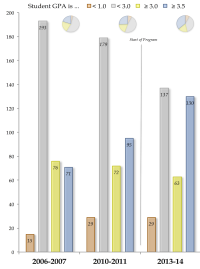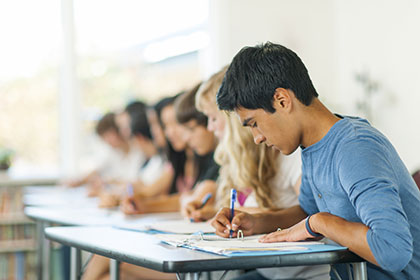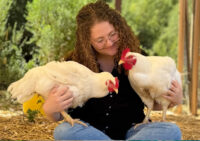John Kelly | Special to the Sun
 As a birthday gift to myself this year I spoke at “Career Day” at Adele Harrison Middle School in Sonoma. I always find it rewarding to talk with students about their plans for the future. But this year, and in this instance, I had just that little extra bit of a reason to be positive. Because I’ve been spending some time reviewing a record of consistent improvement delivered by students just like those I spoke to when they reach Sonoma Valley High.
As a birthday gift to myself this year I spoke at “Career Day” at Adele Harrison Middle School in Sonoma. I always find it rewarding to talk with students about their plans for the future. But this year, and in this instance, I had just that little extra bit of a reason to be positive. Because I’ve been spending some time reviewing a record of consistent improvement delivered by students just like those I spoke to when they reach Sonoma Valley High.
Recent research shows that middle school attendance and GPA, when combined, is the single best predictor of high school GPA. Qualitatively, most (public) high schools grade students similarly; however, similar students perform differently depending on the school, with some schools improving performance up to .5 of a grade point – and with most of those benefits received by the students between a 1.0 and a 3.0.
Those students who manage to reach or exceed a 3.0 in high school increase both their chances of attending college, and graduating from college. The higher their GPA moves, the better those chances become.
The research really caught my eye because, beginning in 2011, Sonoma Valley High School created their Freshman Teams, small communities of incoming students with shared schedules. To the extent that the context students enter high school can affect performance, should the Freshman Teams have been functioning positively, an improvement of approximately .5 of a GPA would be expected, with the primary benefits impacting students who would have earned between a 1.0 and a 3.0.
And lo and behold the graph shows exactly what I’d hoped when I started looking at this data. Since the program was instituted in the 2011-2012 school year, Sonoma Valley Unified has moved the majority of its students into the college-potential category as of the end of freshman year, nearly doubling the number in the top tier. Attendance improvements were positively correlated with GPA improvements. Further, as would be expected, the biggest GPA change impacted students between a 1.0 and a 3.0, with essentially a third of the students expected to fall into the range moving into the college potential or college probable tiers.
That wasn’t all — at the same time this was going on, the number of students taking accelerated coursework (math and language) nearly doubled. Sonoma Valley High gives the students no break on grading for their initiative in choosing a harder schedule – there is no bonus weight assigned to their GPAs for this effort. So not only are the students earning better grades, they’ve been doing it taking harder classes at the same time.
The students I saw at Adele will now more likely than not be in a position to pursue college when they attend Sonoma Valley High in the years to come. And the question this data makes me ask myself is: will we give these students the schools and the facilities that their performance deserves?
Can we execute on our school district’s Master Plan?
The voters of Sonoma have long been the heroes of their own community’s schools. The electors of the Valley, time and again, have fully committed to public stewardship of our educational infrastructure. As parents (and grandparents), our lived experience shows the enormous benefits to health, safety and education that have always accrued from carefully spending the money necessary to develop the structures, fields and facilities worthy of a Valley as successful as Sonoma.
The men and women of our community have always counted on their educators and trustees to manage — cautiously — the development of our school campuses. We as a community know we’ll face expenses to maintain our District, and we’ll have to frugally weigh options, one against the other. As prudent shoppers, now is the time to write our list of the purchases we know we’re going to need — the framework for accelerating our students into the balance of the 21st century that lies ahead.
The green eye shade of the accountant, and the graphs of the economist make the dry case for improving our schools — that action now can reap outsized dividends, consequences we will see in the improved living standards and enhanced productivity of our entire community. But it is our concern for justice that should ultimately resolve questions in favor of an investment in our shared future.
Our shared belief is that America is defined by the notion that the condition of your birth does not determine the outcome of your life. Whether Republican or Democrat, liberal or conservative, our covenant with our future selves is that education will remain the key to unlocking the American Dream.
Yet we find ourselves in a time where educational opportunity in the United States has become inverted. We are one of only two members of the G20 that spends more on richer students than poorer (the other is Turkey). We cannot rely on the State of California to resolve these issues for us. Our Governor is backing away from California’s School Facilities Program.
The State is essentially leaving Districts like ours on their own in providing for future school facilities and modernization.
This is where the case for implementing the District’s master plans, now, for all of the campuses, finds real traction. As Winston Churchill said, “we shape our buildings; thereafter they shape us.” The voters of Sonoma have a once-in-a-generation opportunity to shape the future of the Valley for decades to come — and there is no one else ready, willing, and capable of doing so.
John Kelly is a Sonoma County native, and has lived in the city of Sonoma since 2001. This article originally appeared at http://blog.law-kelly.com.
Master Plan for SVHS
The District plan calls for, among other improvements, these upgrades to the 1992 campus:
- 400-seat auditorium
- A quad and possible amphitheater to replace Building G
- New student services building
- New buildings for the Ag program including a shop, a show arena and stands
- Additional classrooms, with vineyard, garden and orchard
- 35-meter pool, four more tennis courts, four new baseball diamonds
- 3,500-seat football/soccer field with artificial turf surrounded by an eight-lane all-weather track.
- Incorporate green technology to reduce campus consumption of natural resources while improving the learning environmen










Be First to Comment